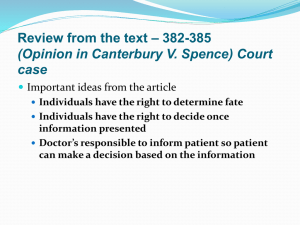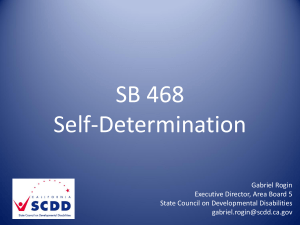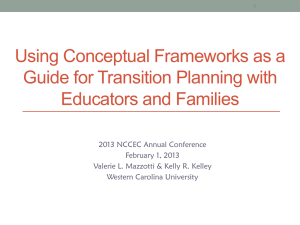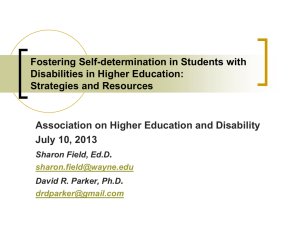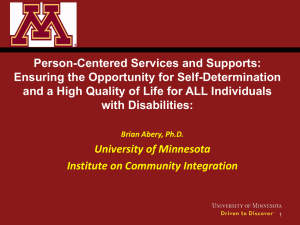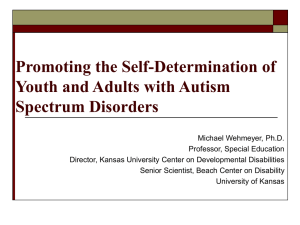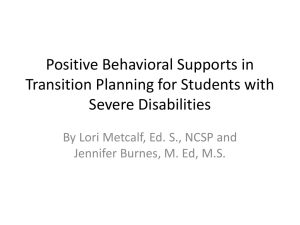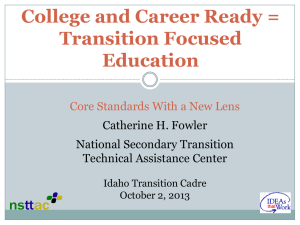What is Self-Determination and Why is it Important
advertisement
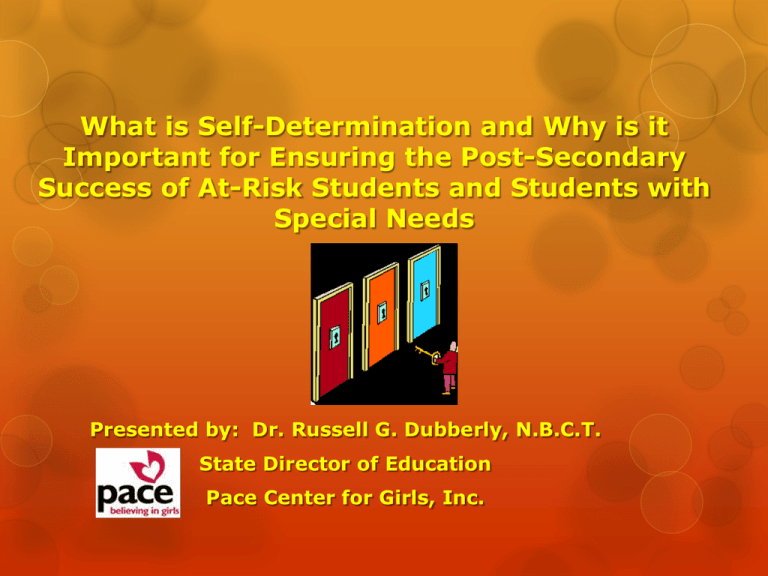
What is Self-Determination and Why is it Important for Ensuring the Post-Secondary Success of At-Risk Students and Students with Special Needs Presented by: Dr. Russell G. Dubberly, N.B.C.T. State Director of Education Pace Center for Girls, Inc. Self-Determination Self-Determination is: A foundation of human will, a lifting of the spirit, and a right of all people. Agran, Snow, and Swaner (1999) listed the following constructs that encompass self-determination: (a) decision making, (b) problem solving, (c) choice making, (d) self-management, (e) self-awareness, (f) self-advocacy (g) goal setting. Self-Determination as a Construct Wehmeyer (2005) reported that selfdetermination can be described in different constructs that relate to (a) a process or outcome, (b) an independent performance of behavior, (c) selfreliance or self-sufficiency, and (d) a behavior that is successful, as something you do or as just choice. Positive Outcomes Wehmeyer and Palmer (2003) found that students with disabilities labeled as having higher levels of self-determination at graduation were more likely to have moved out of the home that they lived in during high school and into their own home by their 3rd year as a post-graduate. Wehmeyer and Palmer also found that students with disabilities labeled as having higher levels of self-determination were also disproportionately more likely to be competitively employed one year after graduation. Self-Determination for Students with Special Needs Self-determination is an integral component for special needs and at-risk students to participate successfully in transition planning, graduation, and achievement of meaningful post-school outcomes. The Educator’s Role If the plan is to truly endure the school year and beyond, teachers need to ensure that at-risk students understand components of (a) decision making, (b) problem solving, (c) choice making, (d) self-management, (e) self-awareness, (f) selfadvocacy, and (g) goal setting. Students need to set positive behavioral goals, learn the consequences of their decisions, (based on learned problem solving strategies), and learn to self-monitor their thoughts and actions throughout the school day. Is this just one more thing for busy teachers? Many teachers become concerned with implementing instructional constructs such as self-determination as one more thing that they are asked to do: Are there curricula for specifically teaching self-determination skills??? Yes. Are there lesson plans specifically for teaching selfdetermination??? Yes. Do you have to teach self-determination like this??? No. Self-determination can be a component of lessons, without being the main focus of the lesson. Self-Determination for At-Risk Students Thoma, Nathanson, Baker, and Tamura (2002) suggested “Educators should learn new strategies that support student self-determination, not only throughout the transition process but also in educational program development in the years proceeding transition planning” (p. 83). Dropping Out of School The primary reason nearly half of the young adults gave for dropping out was that classes were uninteresting. In general, feeling unmotivated or uninspired to work hard was a significant factor in the drop outs’ discontent with school. In focus groups, the young adults said school was boring, they didn’t learn anything, and school was irrelevant. Does this sound like a group who needs to learn to be more self-aware, set goals, self-advocate, and become empowered to shape their own educational direction??? Bridgeland, DiIulio, and Morison (2006) Goal Setting Teachers need to work collaboratively with students and their families to set meaningful goals. Differentiated Instruction Multiple pathways to success – College is not for everyone. Individualized accommodations Find personal goal-related curricula and materials Build a network and supports for the student’s goal The art of lawnmower repair – Think outside of the box! A Starting Place for Students At-Risk An understanding of one's strengths, abilities, needs, limitations, interests, and preferences may provide an important foundation for promoting other selfdetermination elements (Wehmeyer & Field, 2007). This requires honest conversation with emphasis on building a path from where the student currently is in development to attainable short term and long term goals. How do you eat an elephant………..One bite at a time! Providing multiple pathways and backup plans. “I want to be a doctor in a hospital” (The student is currently struggling with science and does not show interest in subjects like biology). This is where a teacher has an opportunity to learn what is really intriguing about the goal and help find pathways to this goal or a similar more attainable goal. Self-Determination as a Protective Factor PACE Center for Girls- We create and help sustain protective factors in girls deemed at-risk. Continuing education and autonomy are two critical factors to our girls’ success! Many of our girls have experienced negative life events that led them to reduced self-determination. For teenagers and young adults, examples of negative life events include parental separation and divorce, parental or family discord, and impaired or neglectful parenting (Bureau, Genevie, Vallerand, Rousseau, & Otis, 2012), as well as many other factors such as drug use, sexual abuse, gang affiliation, bullying, etc. Acting out of self-determination is a functioning mode where people regulate their behaviors according to their own values and preferences. Intrinsic Versus Extrinsic Highly self-determined individuals behave mostly out of personal relevance. Their action is proactive and is thoughtfully chosen to be in line with their core values. In contrast, non-self-determined individuals act to gain rewards, avoid punishments, and because they feel they ought to behave in a certain way. These behavioral standards are imposed on them by others and are not self-endorsed (Deci & Ryan, 2002). As a result, non-self-determined individuals are dependent on environmental cues to motivate their action (Deci & Ryan, 2002). Their general perceived locus of causality is thus external, making them more reactive to external cues. Self-Determination as a Protective Factor Consider the profile of many students who are at greatest risk for dropping out (depressed, low self-esteem, feeling of lack of options, negativity, feeling of no control, highly stressed). Self-determination predicts numerous positive outcomes including reduced depression, higher self-worth, greater creativity, more positive emotions, stronger perceptions of control, and less anxiety. (Bureau, et al. 2012). Bureau, et al found when people are highly self-determined, the deleterious effects of negative life events and hopelessness are less systematic. Their results suggested that self-determined people may have developed a proactive way of life that makes them less affected by negative life events. Strategies to Build Self-Determination in Children Considered At-Risk for Dropout 1. Prerequisite social skills, such as giving positive feedback and giving criticism. 2. Self-evaluation skills, such as evaluating present skills, and evaluating skills needed for future goals. 3. Self-Direction skills, such as action planning and goal setting. 4. Networking skills, both formal and informal networking. 5. Collaboration skills, such as determining team needs and teaming to develop goals. 6. Persistence and risk-taking skills, such as persistence through problem solving and risk-taking through decision making. 7. Dealing with stress, such as recognizing feelings and expressing feelings appropriately. (Serna & Lau-Smith, 1995) PURPOSE is a mnemonic for the following: Prepare to learn the specific self-determine skill Understand the skills through a discussion about these components with regard to definition and rationale for use Rehearse by practicing that skill with a peer after watching the instructors model the behavior Perform a self-check Overcome any performance barriers as well as generalize the skill to other situations Select his or her performance in those situations Evaluate his or her performance in those situations (Serna & Lau-Smith, 1995) Find the Fun in Education……… The Fun Theory References Agran, M., Snow, K., & Swaner, J. (1999). Teacher perceptions of self-determination: Benefits, characteristics, strategies. Education and Training in Mental Retardation and Developmental Disabilities, 34, 293-301. Bridgeland, J. M., DiIulio, J. J., Morison, K. B. (2006). The Silent Epidemic Perspectives of High School Dropouts. Retrieved from http://www.americaspromise.org/~/media/Files/Resources/the_silent_epidemic_report-RES.ashx Bureau, J. S., Genevie, A. Vallerand, R. J., Rousseau, R. L., & Otis, J. (2012). Self-Determination: A Buffer Against Suicide Ideation. Retrieved from The American Association of Suicidology/Academic Edition database. Deci, E. L., & Ryan, R. M. (2002). Overview of self-determination theory: An organismic dialectical perspective. In E. L. Deci & R. M. Ryan (Eds.), Handbook of self-determination research (pp. 3–33). Rochester, NY: University of Rochester Press. Serna, L. A., & Lau-Smith, J. (1995). Learning with purpose: Self-determination skills for students who are at risk for school and community failure. Interventions in School and Clinic, 30(3), 142-146. Wehmeyer, M. L. (2005). Self-determination and individuals with severe disabilities: Re-examining meanings and misinterpretations. Research and Practice for Persons With Severe Disabilities, 30, 113-120.
